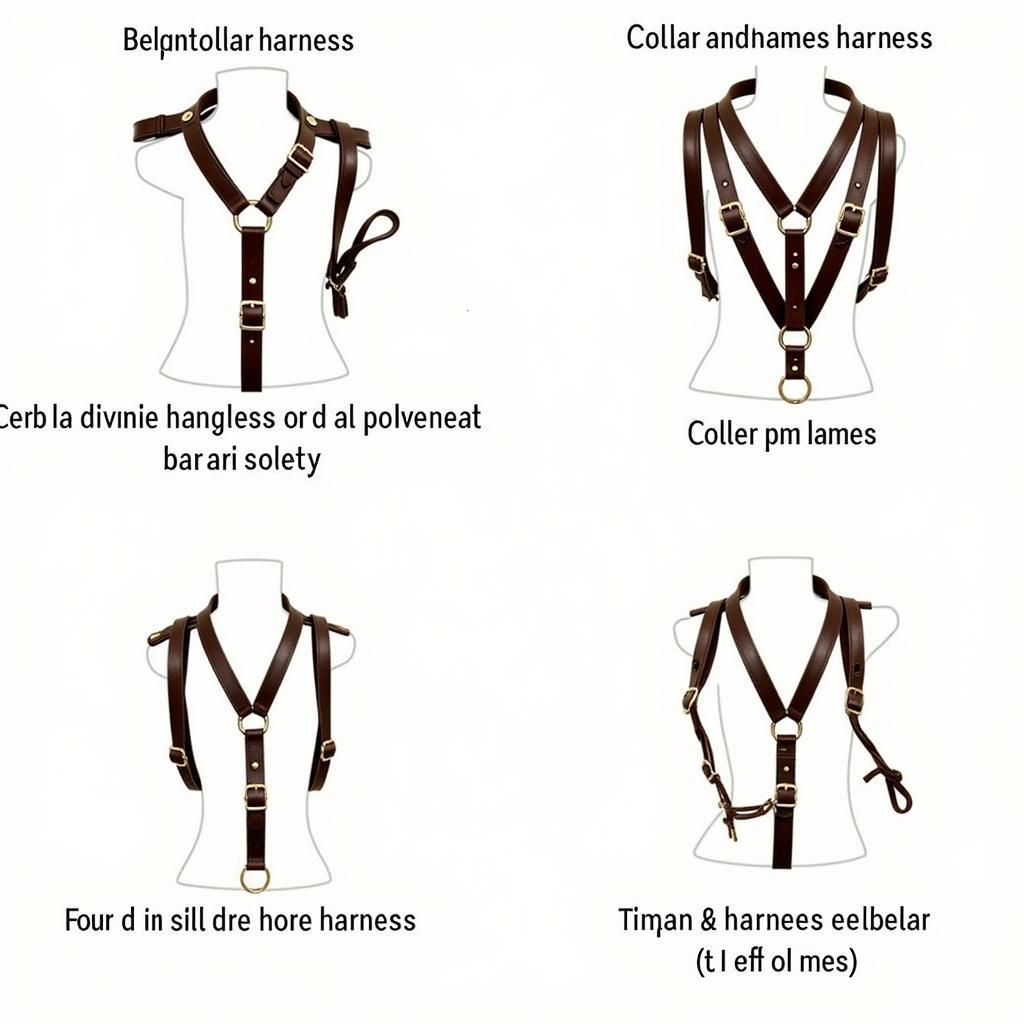A Leather Horse Driving Harness is a crucial piece of equipment for anyone involved in driving horses, whether for pleasure, competition, or work. Choosing the right harness ensures both the horse’s comfort and the driver’s safety. This comprehensive guide will delve into the key aspects of selecting, fitting, and maintaining a leather horse driving harness.  Different Types of Leather Driving Harnesses
Different Types of Leather Driving Harnesses
Understanding the Different Types of Leather Horse Driving Harnesses
There are several types of leather horse driving harnesses, each designed for specific purposes and horse conformations. The most common types include:
- Breastcollar Harness: Ideal for lighter work and pleasure driving, the breastcollar harness distributes pressure across the horse’s chest and shoulders. This type of harness is often preferred for horses with sensitive necks or those performing less strenuous tasks.
- Collar and Hames Harness: This harness utilizes a collar and hames to distribute the pulling weight across the horse’s shoulders and chest, making it suitable for heavier work. It’s a common choice for draft horses and those used in agricultural or logging activities.
- Combined Harness: This harness combines elements of both the breastcollar and collar and hames harness, offering versatility for a range of driving activities.
Choosing the correct harness type depends on the horse’s build, the type of driving you’ll be doing, and the weight of the carriage or implement being pulled.
Key Considerations When Selecting a Leather Horse Driving Harness
Beyond the basic harness types, several other factors influence your choice.
- Leather Quality: Opt for high-quality, supple leather that is durable and resistant to cracking. Full-grain leather is generally the best option, offering superior strength and longevity.
- Fit: A proper fit is essential for the horse’s comfort and performance. The harness should be snug but not restrictive, allowing for a full range of motion.
- Hardware: The buckles, rings, and other hardware should be made of sturdy, rust-resistant materials like stainless steel or brass.
- Stitching: Examine the stitching carefully to ensure it is strong and even. Double-stitched seams are generally more durable.
Maintaining Your Leather Horse Driving Harness
Proper care and maintenance will significantly extend the life of your leather horse driving harness.
- Cleaning: Regularly clean the harness with a damp sponge and saddle soap to remove dirt and sweat.
- Conditioning: After cleaning, apply a leather conditioner to keep the leather supple and prevent cracking.
- Storage: Store the harness in a cool, dry place away from direct sunlight.
- Inspection: Regularly inspect the harness for signs of wear and tear, paying particular attention to the stitching, buckles, and leather straps.
“Regular maintenance is crucial,” says renowned equine expert Dr. Amelia Carter, “A well-maintained leather harness not only looks better but also performs better and lasts longer.”
What is the Purpose of a Leather Horse Driving Harness?
A leather horse driving harness is designed to safely and effectively connect a horse to a carriage or other implement, allowing the driver to control the horse’s movement and speed. It distributes the pulling weight evenly across the horse’s body, preventing discomfort and injury. Remember, tack for mini horses will differ from a full-sized horse.
How Do I Choose the Right Size Leather Horse Driving Harness?
Choosing the correct size harness is vital for the horse’s comfort and well-being. Measuring your horse accurately is essential. Consult a harness fitting guide or a professional harness fitter for assistance in determining the appropriate size.
Why is Leather Preferred for Horse Driving Harnesses?
Leather is a popular choice for horse driving harnesses due to its durability, flexibility, and traditional aesthetic. It conforms to the horse’s body over time, providing a comfortable and secure fit.
Conclusion
Investing in a high-quality leather horse driving harness is an investment in both your horse’s comfort and your own safety. By understanding the different types of harnesses available, considering key factors when selecting a harness, and implementing proper maintenance practices, you can ensure years of enjoyable and safe driving experiences. Consider checking out our selection of horse bridle and breastcollar sets as well.
FAQ
- What type of leather is best for a driving harness?
- How often should I clean my leather harness?
- How do I store my leather harness?
- What are the signs of a worn-out harness?
- How do I adjust a leather horse driving harness?
- Can I use a riding saddle on a driving horse?
- Where can I find a qualified harness fitter?
For further information, explore our articles on bells for horse harness and horse pulling collar. You may also be interested in pulling collar for horses.
When you need assistance, please contact us at Phone Number: 0772127271, Email: [email protected] Or visit us at: QGM2+WX2, Vị Trung, Vị Thuỷ, Hậu Giang, Việt Nam. We have a 24/7 customer service team.